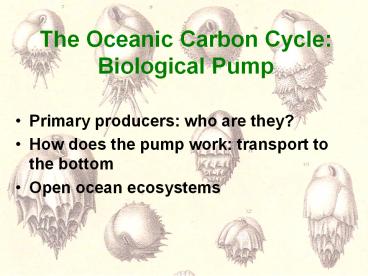The Oceanic Carbon Cycle: Biological Pump - PowerPoint PPT Presentation
Title:
The Oceanic Carbon Cycle: Biological Pump
Description:
The Oceanic Carbon Cycle: Biological Pump Primary producers: who are they? How does the pump work: transport to the bottom Open ocean ecosystems high diversity: DEEP ... – PowerPoint PPT presentation
Number of Views:542
Avg rating:3.0/5.0
Title: The Oceanic Carbon Cycle: Biological Pump
1
The Oceanic Carbon CycleBiological Pump
- Primary producers who are they?
- How does the pump work transport to the bottom
- Open ocean ecosystems
2
high diversityDEEP SEA
3
Deep-Sea diverse life forms
- Deep-sea thought to be without life (azoic)
until 19th century deep-sea exploration
expeditions - Erebus and Terror, 1839-1843, James Ross
Clark - Lightning and Porcupine, 1868-1869, Wyville
Thompson - Challenger, 1872-1876, Wyville Thompson, J. W.
Murray (ForaminiferaH .B. Brady, 1884)
4
SURFACE OCEAN PRIMARY PRODUCTIVITY
Satellite data (CZCS, SeaWIFS)
High productivity input of nutrients (N, P) from
land Seasonality
5
Oceanic spring bloom (high-mid latitudes)
- Winter light limitation (insolation, storms mix
phytoplankton below photic zone) - Nutrients not (fully) used accumulate
- Spring more light, warming causes
stratification, keeps plankton within photic zone - Bloom (until nutrients used up, zooplankton eats
phytoplankton)
6
EUKARYOTES(multicellular)FungiAnimaliaPlantae
PROTISTS EUKARYOTES (unicellular)
LIFE ON EARTH
PROKARYOTES
- Molecular phylogenies
- Protein sequences
- Small subunit RNA
7
Oceanic primary producers
- Prokaryotes (unicellular, simple cell, asexual
reproduction 0.6 mm) - cyanobacteria
Prochlorococcus, Synechococcus) up to 2/3 of
primary productivity in the oceans - Eukaryotes (complex cell - nucleus - sexual and
asexual reproduction tens of mm) - Bacillariophyceae - Opaline Silica skeleton
Diatoms - Haptophyceaea
- Calcium-carbonate skeleton Calcareous
Nannoplankton - No skeleton Phaeocystis
- Dinophyceae - organic -walled cysts
Dinoflagellates
8
CALCAREOUS NANNOPLANKTON
COCCOLITHOPHORES
- Polysaccharide gels (transparent exopolymer
particles)
(Haptophyte Algae) Diameter 20-30 mm
9
(No Transcript)
10
Planktonic foraminifer
11
Prymnesiophytes (Haptophytes) -Phaeocystis
- Polysaccharide gels (transparent exopolymer
particles)
12
Transparent Exopolymer Particles
- Phaeocystis blooms at high latitudes (survive in
sea ice) - 10 of annual global marine primary productivity
- Much of this in form of gels - major part of
dissolved organic carbon in oceans - Secrete dimethylsulfide - add sulfur to atmosphere
13
Diatoms
- Today up to 20-40 net primary production, 50
organic carbon exported
14
Diatoms
- Rapid delivery of diatoms to sea floor in frontal
zones (Kemp et al., 2006) - giant diatoms in mats e.g., Fragilariopsis,
Thalassiothrix, Rhizosolenia
15
Dinoflagellates
- Dinophyceae
16
Dinoflagellates harmful algal blooms (HABs)
17
Type of primary producers/productivity of oceans
- Open ocean, low productivity (central gyres)
prokaryotes, some dinoflagellates - Open ocean, higher productivity calcareous
nannoplankton - Open ocean, highest productivity diatoms,
Phaeocystis - Coastal ocean, high productivity
dinoflagellates, Phaeocystis
18
Oceanic primary productivity different dominant
producers - fertility
ANNUAL
19
Deep-sea environment cold, dark,high pressure,
very little food.
Food supplied by surface productivity, miles up
biological pump
20
How much food reaches the bottom?Not very much
(lt1 to few of PP)
- e.g., Martin et al., 1987 north-east Pacific
stations - F1.53(z/100)-0.858
- zdepth
21
Oceanic food chain
22
Food from surface to bottombiological pumphow
does it work?
- Marine snow (4 mm particle, dead and dying
phytoplankton, zooplankton exoskeletons, fecal
matter) - 102-103 m/day
23
Organic matter from surface to bottombiological
pump
- Ballasted by
- silica (diatoms)
- carbonate (foraminifera, nannoplankton)
- terrigenous dust
- In fecal pellets
- Stuck together by polysaccharides (Phaeocystis,
diatoms, cyanobacteria, calcareous nannoplankton) - In giant balls of mucus - larvacean houses
- Carrion falls (dead whales)
- Lateral transport (refractory organic matter)
- Discrepancy between food requirements of faunas
and supply in sediment traps faunas need more
than what is delivered
24
Larvacean houses (tunicates)2-3 feet diameter
- Tunicates are Chordates (related to us
vertebrates - lancelet fish)
25
- We do not understand transport of organic matter
to the sea floor in the present ocean, nor
importance of prokaryotic productivity - We can not predict the effects of global warming
and increased nutrients on carbon cycle in the
oceans
26
Oceanic primary productivity - how limited?
Transport to sea floor - how limited? Can we
manipulate (carbon sequestration)?
27
In some regions N and P are NOT limiting
- "high-nutrient, low-chlorophyll (HNLC) regions,
e.g. equatorial Pacific - Not enough iron (Fe)
28
(No Transcript)
29
(No Transcript)

